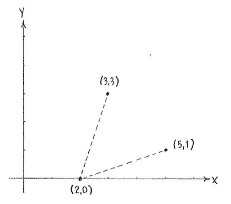Lösung 4.1:4c
Aus Online Mathematik Brückenkurs 1
K (hat „Solution 4.1:4c“ nach „Lösung 4.1:4c“ verschoben: Robot: moved page) |
|||
| Zeile 1: | Zeile 1: | ||
| - | + | Die ''x''-Achse besteht aus allen Punkten <math>(x,0)</math>, wo ''x'' unbekannt ist. Mit der Formel für den Abstand zwischen zwei Punkten, erhalten wir den Abstand zwischen <math>(x,0)</math> und <math>(3,3)</math> und zwischen <math>(5,1)</math> und <math>(x,0)</math>, | |
| - | <math>(x,0)</math> | + | |
| - | {{Abgesetzte Formel||<math>\sqrt{(x-3)^2+(0-3)^2}\qquad\text{ | + | {{Abgesetzte Formel||<math>\sqrt{(x-3)^2+(0-3)^2}\qquad\text{und}\qquad \sqrt{(x-5)^2+(0-1)^2}\,\textrm{,}</math>}} |
| - | + | Nachdem die beiden Abstände gleich sein sollen, erhalten wir | |
{{Abgesetzte Formel||<math>\sqrt{(x-3)^2+9} = \sqrt{(x-5)^2+1}</math>}} | {{Abgesetzte Formel||<math>\sqrt{(x-3)^2+9} = \sqrt{(x-5)^2+1}</math>}} | ||
| - | + | Wir quadrieren diese Gleichung und erhalten | |
{{Abgesetzte Formel||<math>(x-3)^2 + 9 = (x-5)^2+1\,\textrm{.}</math>}} | {{Abgesetzte Formel||<math>(x-3)^2 + 9 = (x-5)^2+1\,\textrm{.}</math>}} | ||
| - | + | Wir erweitern alle Terme, und sammeln danach alle Terme auf einer Seite, | |
{{Abgesetzte Formel||<math>\begin{align} | {{Abgesetzte Formel||<math>\begin{align} | ||
| Zeile 19: | Zeile 18: | ||
\end{align}</math>}} | \end{align}</math>}} | ||
| - | + | Dies ergibt <math>x=2</math>, und also ist der Punkt auf der ''x''-Achse <math>(2,0)\,</math>. | |
[[Image:4_1_4_c-1(2).gif|center]] | [[Image:4_1_4_c-1(2).gif|center]] | ||
| - | + | Zum Schluss kontrollieren wir ob die beiden Abstände auch wirklich gleich sind. Der Abstand zwischen <math>(2,0)</math> und <math>(3,3)</math> | |
| - | + | ist | |
| - | + | ||
{{Abgesetzte Formel||<math>\sqrt{(3-2)^2 + (3-0)^2} = \sqrt{1^2+3^2} = \sqrt{1+9} = \sqrt{10}</math>}} | {{Abgesetzte Formel||<math>\sqrt{(3-2)^2 + (3-0)^2} = \sqrt{1^2+3^2} = \sqrt{1+9} = \sqrt{10}</math>}} | ||
| - | + | und der Abstand zwischen <math>(2,0)</math> und <math>(5,1)</math> ist | |
{{Abgesetzte Formel||<math>\sqrt{(5-2)^2 + (1-0)^2} = \sqrt{3^2 + 1^2} = \sqrt{9+1} = \sqrt{10}\,\textrm{.}</math>}} | {{Abgesetzte Formel||<math>\sqrt{(5-2)^2 + (1-0)^2} = \sqrt{3^2 + 1^2} = \sqrt{9+1} = \sqrt{10}\,\textrm{.}</math>}} | ||
| - | + | Hinweis: Obwohl wir unsere Gleichung quadriert haben, besteht kein Risiko Scheingleichungen zu erhalten, nachdem die Quadraten in der Wurzel immer positiv sind. | |
| - | + | ||
Version vom 17:17, 2. Apr. 2009
Die x-Achse besteht aus allen Punkten \displaystyle (x,0), wo x unbekannt ist. Mit der Formel für den Abstand zwischen zwei Punkten, erhalten wir den Abstand zwischen \displaystyle (x,0) und \displaystyle (3,3) und zwischen \displaystyle (5,1) und \displaystyle (x,0),
| \displaystyle \sqrt{(x-3)^2+(0-3)^2}\qquad\text{und}\qquad \sqrt{(x-5)^2+(0-1)^2}\,\textrm{,} |
Nachdem die beiden Abstände gleich sein sollen, erhalten wir
| \displaystyle \sqrt{(x-3)^2+9} = \sqrt{(x-5)^2+1} |
Wir quadrieren diese Gleichung und erhalten
| \displaystyle (x-3)^2 + 9 = (x-5)^2+1\,\textrm{.} |
Wir erweitern alle Terme, und sammeln danach alle Terme auf einer Seite,
| \displaystyle \begin{align}
& x^2-6x+9+9 = x^2-10x+25+1\\[5pt] &\quad\Leftrightarrow\quad 4x-8=0\,\textrm{.} \end{align} |
Dies ergibt \displaystyle x=2, und also ist der Punkt auf der x-Achse \displaystyle (2,0)\,.
Zum Schluss kontrollieren wir ob die beiden Abstände auch wirklich gleich sind. Der Abstand zwischen \displaystyle (2,0) und \displaystyle (3,3) ist
| \displaystyle \sqrt{(3-2)^2 + (3-0)^2} = \sqrt{1^2+3^2} = \sqrt{1+9} = \sqrt{10} |
und der Abstand zwischen \displaystyle (2,0) und \displaystyle (5,1) ist
| \displaystyle \sqrt{(5-2)^2 + (1-0)^2} = \sqrt{3^2 + 1^2} = \sqrt{9+1} = \sqrt{10}\,\textrm{.} |
Hinweis: Obwohl wir unsere Gleichung quadriert haben, besteht kein Risiko Scheingleichungen zu erhalten, nachdem die Quadraten in der Wurzel immer positiv sind.

